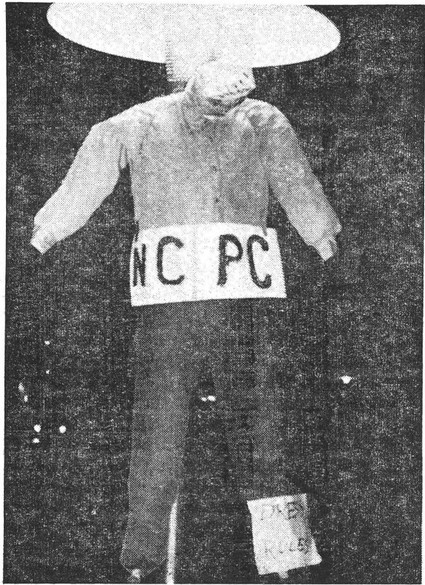Halloran House Protest (1963)
Introduction
Text-to-speech Audio
At this location in the fall of 1963, several hundred Ohio State University students participated in a variety of protests against the gender-specific dress codes and other rules that applied to female students. While Ohio State University did not have a dress code, female students who lived in the dorms that were open to women were required to meet certain standards of dress and behavior along with expected curfews and other rules that did not apply to men. Halloran House was the site of a protest that included both male and female students who came together to challenge a rule against wearing sweatshirts that originated with rules that female students were expected to follow but was formally expanded to include all students.
Images
Lantern photo of an effigy of North Campus Provisional Council hung from Halloran House to protest the new dress code. This was taken on October 25, 1963.

Backstory and Context
Text-to-speech Audio
The Ohio State University had a series of rules and regulations set by the Women’s Self-Government Association throughout the sixties. However, through the 1900s and onward various organizations held women at Ohio State accountable for higher standards than their male counterparts. Regulations progressed as time went on, and in the sixties, a majority of fairly strict regulations began to come into question.
The Women’s Self-Government Association (WSGA) was an organization on the Ohio State University campus that aimed to set “women’s rules” and enforce its codes of conduct. The WGSA was often criticized despite all Ohio State students becoming members. The governing of women's behaviors at OSU began with the Women's Council in 1903. It was later referred to as Women Affected by Man Shortage (WAMS) in the 1940s and the WGSA in the 1950s. WGSA claimed their objective was not to punish women, despite sending detailed handbooks to all incoming Freshman women with rules ranging from dress code to curfew, to male visitors to living situations.
In 1960, women who went to men’s apartments could be placed on probation. As the next few years progressed, the rules were relaxed by allowing upper-class women with parental permission to visit a man’s apartment with another woman present. In 1967, women with extended curfews could stay at a man’s apartment without parental permission with another woman present until 6:30 am.
The increased regulation of women’s behavior could be highlighted in other jurisdictions made by the WGSA. For example, in 1958, the WGSA passed rules that recommended women clap their hands after each song at men’s performances. In 1960, the board recommended women students not wear shorts or slacks.
Ohio State did not have an official dress code for students, but student residents living in the dorms did have to follow requirements for how to dress. Women were also required to live in the dorms for all four years until the mid-1960s. A chart from the 1960s in a WGSA handbook required skirts, shirts, cardigans, heavy sweaters, blouses, or shirtwaists for classes with loafers and knee socks, or hose, sandals, or flats for footwear. For auditorium plays, concerts, teas, and church, women were mandated to wear wool dresses, cotton or wool suits, or other matched outfits. For more casual outings, Levis, bermudas, cut offs, blouses, and sweatshirts were the typical dress code.
A ruling made by North Campus Provisional Council (NCPC) determined that women cannot wear sweatshirts unless it was finals week in October of 1963. Men additionally had to abide by similar rules, despite having no rules for dress prior to this ruling-only social pressures. A protest on the third floor of Halloran House then broke out on October 25, 1963. A group of men (1 from Halloran, 3 from Haverfield) formed a student action committee and made new dress suggestions through the protest and petitions. Nine girls from Baker Hall had been trying to reform the dress code already. No action was taken until the men joined efforts to protest.
On October 30, 1963, over 300 students signed a petition to get rid of the new ruling. In response, NCPC modified the rule on mealtime dress/attire two days later. At their meeting, 575 students (over half of the north campus population) asked to be allowed to wear sweatshirts at breakfast and lunch. Most students supported the previously established rules related to appropriate attire at mealtime, and required that students dress up for special occasions. The meeting resulted in the restoration of the old rules from Scott House, Barrett House, Haverfield House, and Halloran House.
As a whole, the Women’s Self-Government Association essentially stood for setting the guidelines for female students. Their personal goal was to not punish women but to prevent behavior that was deemed unacceptable and most violations were for possession of alcoholic beverages, apartment rulings, and dress codes. They were often met with marks on transcripts, a requirement of counseling services with the dean, probation, or being campused. Many women on campus, especially those in support of women's liberation, felt that the WGSA did not have their best interests at heart. Rather, the women’s liberation movement wanted health centers focusing on sex education, equal punishments and qualifications for men and women, and a student government that represented them. Today, the university has little to no regulations that are specific to women.
Sources
Dobranic, Barbara. "Coed Rules Report Presented to WSGA." The Lantern (Columbus) October 27th 1966. , 1,8.
Dress Codes: On The Clothes Line, Fashion2Fiber. Accessed December 6th 2021. https://fashion2fiber.osu.edu/exhibits/show/campus-fashion--150-years-of-c/advice-and-advertising-to-the-/dress-codes--on-the-clothes-li.
Hill, Jackie. "How To Dress At Mealtime Has North Campus In Arms." The Lantern (Columbus) October 25th 1963. , 1,10.
Reisinger, Sue. "WSGA Breeds Controversy, Liberalizes Women ' s Rules." The Lantern (Columbus) September 27th 1967. .27.
Sarna, Dorothy. "Rules For Women Are Concern Of 'Standards '." The Lantern (Columbus) October 25th 1960. 4.
The Lantern (Columbus) October 30th 1963.
The Lantern (Columbus) November 2nd 1963.
The Lantern, 25 October 1963
